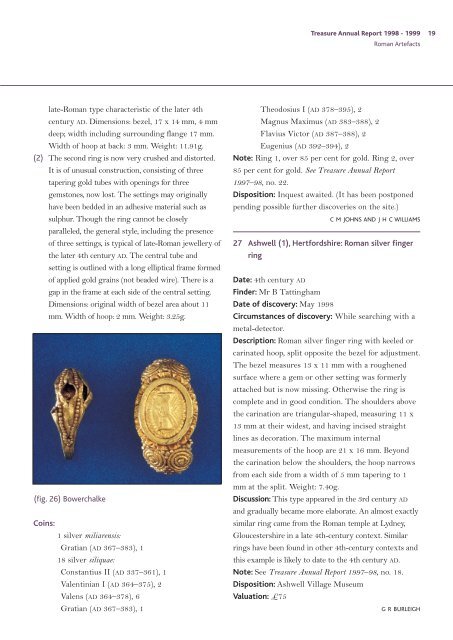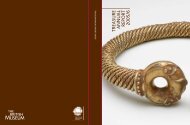Treasure Annual Report 1998-1999 - Portable Antiquities Scheme
Treasure Annual Report 1998-1999 - Portable Antiquities Scheme
Treasure Annual Report 1998-1999 - Portable Antiquities Scheme
You also want an ePaper? Increase the reach of your titles
YUMPU automatically turns print PDFs into web optimized ePapers that Google loves.
late-Roman type characteristic of the later 4th<br />
century AD. Dimensions: bezel, 17 x 14 mm, 4 mm<br />
deep; width including surrounding flange 17 mm.<br />
Width of hoop at back: 3 mm. Weight: 11.91g.<br />
(2) The second ring is now very crushed and distorted.<br />
It is of unusual construction, consisting of three<br />
tapering gold tubes with openings for three<br />
gemstones, now lost. The settings may originally<br />
have been bedded in an adhesive material such as<br />
sulphur. Though the ring cannot be closely<br />
paralleled, the general style, including the presence<br />
of three settings, is typical of late-Roman jewellery of<br />
the later 4th century AD. The central tube and<br />
setting is outlined with a long elliptical frame formed<br />
of applied gold grains (not beaded wire). There is a<br />
gap in the frame at each side of the central setting.<br />
Dimensions: original width of bezel area about 11<br />
mm. Width of hoop: 2 mm. Weight: 3.25g.<br />
(fig. 26) Bowerchalke<br />
Coins:<br />
1 silver miliarensis:<br />
Gratian (AD 367–383), 1<br />
18 silver siliquae:<br />
Constantius II (AD 337–361), 1<br />
Valentinian I (AD 364–375), 2<br />
Valens (AD 364–378), 6<br />
Gratian (AD 367–383), 1<br />
<strong>Treasure</strong> <strong>Annual</strong> <strong>Report</strong> <strong>1998</strong> - <strong>1999</strong> 19<br />
Roman Artefacts<br />
Theodosius I (AD 378–395), 2<br />
Magnus Maximus (AD 383–388), 2<br />
Flavius Victor (AD 387–388), 2<br />
Eugenius (AD 392–394), 2<br />
Note: Ring 1, over 85 per cent for gold. Ring 2, over<br />
85 per cent for gold. See <strong>Treasure</strong> <strong>Annual</strong> <strong>Report</strong><br />
1997–98, no. 22.<br />
Disposition: Inquest awaited. (It has been postponed<br />
pending possible further discoveries on the site.)<br />
C M JOHNS AND J H C WILLIAMS<br />
27 Ashwell (1), Hertfordshire: Roman silver finger<br />
ring<br />
Date: 4th century AD<br />
Finder: Mr B Tattingham<br />
Date of discovery: May <strong>1998</strong><br />
Circumstances of discovery: While searching with a<br />
metal-detector.<br />
Description: Roman silver finger ring with keeled or<br />
carinated hoop, split opposite the bezel for adjustment.<br />
The bezel measures 13 x 11 mm with a roughened<br />
surface where a gem or other setting was formerly<br />
attached but is now missing. Otherwise the ring is<br />
complete and in good condition. The shoulders above<br />
the carination are triangular-shaped, measuring 11 x<br />
13 mm at their widest, and having incised straight<br />
lines as decoration. The maximum internal<br />
measurements of the hoop are 21 x 16 mm. Beyond<br />
the carination below the shoulders, the hoop narrows<br />
from each side from a width of 5 mm tapering to 1<br />
mm at the split. Weight: 7.40g.<br />
Discussion: This type appeared in the 3rd century AD<br />
and gradually became more elaborate. An almost exactly<br />
similar ring came from the Roman temple at Lydney,<br />
Gloucestershire in a late 4th-century context. Similar<br />
rings have been found in other 4th-century contexts and<br />
this example is likely to date to the 4th century AD.<br />
Note: See <strong>Treasure</strong> <strong>Annual</strong> <strong>Report</strong> 1997–98, no. 18.<br />
Disposition: Ashwell Village Museum<br />
Valuation: £75<br />
G R BURLEIGH





